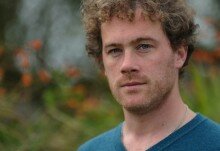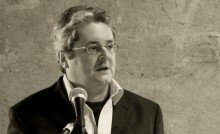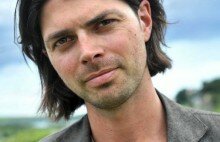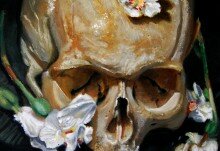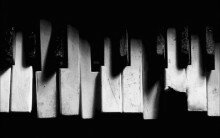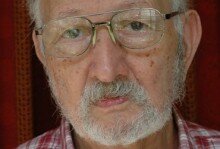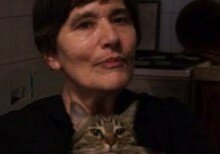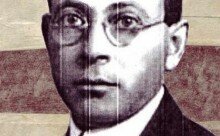Interview with Chris Edwards
Michael Brennan: When did you start writing and what motivated you?
Chris Edwards: I’ve started and stopped a number of times. And started again. My first few attempts, or the first I remember, were high school English assignments: a sci-fi story about a ravenous blob from outer space (who wins in the end, against the odds); a story about a drug dealer who swallows his own supplies and takes a trip through the list of words we were asked to use in our composition; an illustrated ghost story about marital strife and manslaughter. My brother’s teacher, John V. Byrnes, took an interest in me on the basis of the blob story, which he described as “pitiless” after reading it in the school magazine. Mr Byrnes (JVB) was the first person to encourage me to think seriously about writing. Invariably attired when out and about in black beret, blazer, cravat and Jackie O-size octagonal sunglasses, he was a beacon of eccentricity in the world I grew up in: that of Sydney’s Sutherland Shire in the days of Puberty Blues. After he retired, during my last year of high school and my first few years of university, he’d host dinner parties for a small gang of us at what he called the Homestead (his house at Kogarah Bay), and my earliest published poems grew out of group experiments conducted around his dinner table using a fairly anarchic version of the surrealists’ exquisite corpse technique. So part of the motive, I guess, would have been social interaction. I remember a fair bit of laughter, too. Levity, I discovered, though I wouldn’t have used that word at the time, was just as compelling a creative force as the gravity I’d been taught to associate, e.g. but not only, with the great works of literature at high school and at university. At Mr Byrnes’ dinner table, we were just mucking around, but the poems and proto-poems we produced made the world, or the way I saw it, bigger and stranger than it was.
As an undergraduate in the early to mid 1970s, I went along to workshops run by the Sydney University Poetry Society. Dorothy Porter was president at the time. She was a forceful and articulate presence at the workshops and around campus – warm, lively, intelligent, tough – and her passion for poetry – reading it, writing it, talking about it – was infectious, as was her determination to break into print. But once publication enters the picture, the question of motive becomes quite complex, perhaps unfathomable; certainly disturbing, though I didn’t think so at the time. I did publish quite a few poems, mainly in New Poetry, in the mid-to-late 1970s, but stopped publishing in 1980 and eventually stopped writing altogether. When I started again, beginning in 1997/98, by writing (or constructing if you like, or contriving, or concocting) collage-based poems, it was with this passage in mind, by Robert Duncan:
Here I am, at last, I said. Why who cares now, not I, that I imitate or pretend, or sit a great frog in the mighty puddle of my own front room. Here I need not be mature. I can be, as Virginia Admiral used to accuse, wet behind the ears, adolescent indeed. I shall live out my life in this small world, with my imaginary genius, doing as I please . . . with my wits at an end at last.
Later in her career, Dorothy championed lucidity. I likewise consider it a worthy goal, but on the whole I prefer ludicity. I write first and foremost to “exercise my faculties” (another quote from Robert Duncan). Beyond that, I try to create a headspace, for want of a better word, that people other than I can enter, and be briefly whatever it was that first began to wonder – the act, according to Socrates, in which thinking begins.
MB: Who are the writers that first inspired you to write and who are the writers you read now? What’s changed?
Chris Edwards: James Joyce (Dubliners) was the first writer who inspired me to read twentieth-century novelists and poets, T.S. Eliot (‘The Love Song of J. Alfred Prufrock’) the first who inspired me to write. They were both on the school curriculum. So was Kenneth Slessor, whose poems turned Sydney, from my outer suburban vantage point, into a place where poetry, and other sorts of magic, could happen. Later, Mr Byrnes introduced me to other Modernists (Pound, Stein, e.e. cummings, the Dada and Surrealist painters and poets), but the biggest early influence was Robert Duncan, beginning with Derivations: Selected Poems 1950–1956, with its generous selection of Stein imitations, the serious, lucid and politicised poetics of ‘An Essay at War’, the loose, concentrated, musical ludicity of Letters and Writing Writing, and the more problematic (for me) commitment to poetry as a vocation acknowledged in the title Fragments of a Disordered Devotion (one of the books from the 1950s represented in Derivations). When I went on to read Duncan’s later books – The Opening of the Field, Roots & Branches, Bending the Bow and the smaller volumes then evolving into Ground Work – I was enthralled (the word is not too strong) not only by Duncan’s “rhetoric” (his word), but also by the fact that his “grand collage” of styles and structures seemed all of a piece, even though it ranged widely, through “all the old excluded orders . . . all that has been outcast and vagabond” (‘Rites of Participation’), from Stein imitations to formal ballads to imitations of seventeenth-century English metaphysical poets to romantic lyrics (including homosexual love poems) to postmodern or projective verse, and from self-contained sets or suites of poems to discontinuous sequences straddling several books – all of which were seen as components of a single life’s work.
Duncan’s subject matter (“the dream of everyone everywhere”) was similarly large-scale: ancient myths were interwoven with more recent philosophical experiments, current scientific speculations, personal and/or political dramas, the detritus of dreams or snippets of daily life, to create poetic assemblages, themselves parts of a larger assemblage, that to me made uncanny sense. Duncan’s poetry, like my blob, tried to incorporate everything. The essays in which he explained his poetics or explored the poetics of others were similarly expansive in their interests, and the fact that a poet would have a poetics was in itself a revelation. Likewise Duncan’s observation that if you think of a poem (or a book for that matter) as a society of words, its internal organisation is where you should look to gauge its political values, rather than to any political views that may be expressed by the poet. Some poets are tyrants, you know. Duncan called himself an anarchist.
Another early enthusiasm was John Ashbery, primarily (in those days) the Ashbery of The Tennis Court Oath. I’d spend hours taking trips through those cut-ups, one of my favourites being ‘Idaho’, a queer conglomerate of verse, prose and fragments of indeterminate status whose protagonists (Biff, Carol, Patches and others) flit, flirt and flicker their way through scene segments and shards of story that are juxtaposed rather than interwoven, shifting abruptly as they do from the immensely comic to the “intensely serious and really moved . . . lift[ing] corners of the veil for the other to peep through.” I still find reading it a magical experience – interactive, too, since the narratives it comprises, or gives rise to, or conspires to suggest, seem different on each rereading.
Inspirational figures closer to home included younger Sydney-based poets like Robert Adamson – who’d recently published The Rumour and whose Swamp Riddles poems were appearing in newspapers and magazines – John Tranter (particularly Red Movie) and John Forbes, whose earliest poems were appearing in New Poetry. The energy, clarity and tautness of their work cut through the murk of the established canon; they made writing poetry look like an exciting, contemporary, relevant thing to be doing. There were also writers from previous generations – Bruce Beaver, David Malouf, Rodney Hall and John Millett come to mind – who were breaking new ground at the time, but it was Adamson, Tranter and Forbes who seemed to triangulate the future, both in their own poetry and in the magazines they edited – New Poetry, Transit and Surfers Paradise. Melbourne was also lively with Kris Hemensley’s The Ear in a Wheatfield, Walter Billeter’s Etymspheres and Robert Kenny’s Rigmarole of the Hours. Lots of local poets had been reading Ezra Pound, and/or Donald M. Allen’s anthology The New American Poetry, and felt driven to “make it new”, so the general ferment of the poetry scene was an inspiration in itself.
When I look back at what I wrote in those years, which I seldom do, I find traces of all the above at work. The European surrealists (notably Max Ernst, through his paintings and collages) had a significant early impact, with Frank O’Hara (notably Lunch Poems), Charles Olson (The Maximus Poems and Human Universe) and Michael Palmer (specifically C’s Songs and Plan of the City of O) following on later. Olson spoke of “getting rid of the lyrical interference of the individual as ego, of the ‘subject’ and his soul, that peculiar presumption” and of “projective” or “open” verse, which he opposed to “what a French critic calls ‘closed’ verse, that verse which print bred and which is pretty much what . . . persists, at this latter day, as what you might call the private-soul-at-any-public-wall” (‘Projective Verse’). I pursued this confused line of thinking quite happily for a while, but at some point baulked at the assertion that “together, these two, the syllable and the line, they make a poem, they make that thing, the – what shall we call it, the Boss of all, the ‘Single Intelligence’.” That word “Boss” set alarm bells ringing, as did the John Wayne delivery.
Late in the 1970s, Jacques Derrida’s Of Grammatology made me think twice about words like ‘writing’, ‘voice’, ‘trace’ and so on, and Deleuze and Guattari got me thinking about rhizomes. That was after I’d encountered French theory thanks to the Working Papers collective – Paul Foss, Meaghan Morris, George Alexander, Liz Gross, Terry Bell, Graeme Tubbenhauer and others – who were introducing Australian readers for the first time, not without critical and creative insights of their own, to the intellectual wonders then emanating from Paris. I liked the connection they drew between Language, Sexuality & Subversion, as one of their collections was called, and wrote an article about it for New Poetry – not a very good one, but an attempt nonetheless to connect French critiques of Western metaphysics (“the metaphysics of presence”, “phallogocentrism” etc.) to American and Australian critiques of its equivalent in “the poem.” The article appeared in the July–August 1979 issue, along with a set of collage poems called ‘3, 2, 1’ (cut mainly from John Easty’s First Fleet journal, with snippets from Dante, Ficino and me) and a sister article on Les Murray’s collection of critical writings The Peasant Mandarin, in which I took eight laborious pages to say what Samuel Beckett said better in four words: “The voice, God forbid.” And that was pretty much it from me until 2000, when ‘bio’ appeared in Meanjin.
During that interval, I naturally continued . . . to read, for example, though I took less interest in poetry during the 1980s than I had done previously. Gig Ryan, John Forbes, John Ashbery and Robert Duncan were the only poets I considered essential reading for much of that decade. I spent a large part of it in garrets, poring over the collected works of Samuel Beckett and William S. Burroughs. Neither inspired me to plug in my electric typewriter immediately, but both offered valuable leads, as did Marjorie Perloff’s The Futurist Moment, particularly its second chapter, ‘The Invention of Collage’, which I read in the late 1980s or early 90s. If I had to pick just one book that eventually led me back to writing, that would be the one. But again, its effect wasn’t immediate or direct. The Futurist Moment pointed me to other writers, other books, like Derrida’s Glas, an exemplary work of collage in its own right, but also a book about collage – one of the best, in my opinion – though it never actually uses that word.
The Futurist Moment also prompted me to look more closely at the work of Kurt Schwitters, who constructed collage poems the same way he did his various other Merz assemblages: with an equal regard for sense and nonsense (“the fourth dimension of literature” – Gelett Burgess, 1901). Schwitters, like Derrida in Glas, used “remains” to construct multifaceted worlds that one could remain in, fascinated. His Merzbau – he turned most of his house in Hannover into a single, organically expanding assemblage full of shrines, grottos and fetish objects, which was bombed during World War II unfortunately, and exists today only in photos and in the legend that’s grown up around it – was particularly inspiring. It was, I thought, a great example of dwelling in your imagination, built with your own two hands.
Schwitters’ Merzbau provided a formal model for me in poems such as ‘bio’ in utensils in a landscape. So did the Bottle Village constructed by Tressa (Grandma) Prisbrey in Simi Valley, California, beginning in 1956, though I became aware of it only in the 1980s. Needing somewhere to house her collection of 17,000 pencils and wanting to block out the smell from the turkey farm next door, Tressa Prisbrey used material from the local dump to construct, first a house for her pencils, then a whole village where even the walkways are assemblages made from salvaged and recycled remains: here a battered license plate, there a collage of lighters, toy guns, old rocket parts, small Lego pieces, or fragments of tile and pottery. I’ve never been to her village in person (much remains standing in spite of the 1994 earthquake), but aided by the photographs I’ve stumbled across in my travels, I’ve often taken an imaginary stroll through the Round House (made of 13,000 amber-coloured bottles), the Rumpus Room (for grandchildren), Cleopatra’s Bedroom (for “exotic” items), the Viewing Room, the Doll’s Head Shrine, the Spring Garden (featuring large metal springs), the Shell House, the School House, and so on. But Tressa Prisbrey isn’t, or wasn’t, a writer. I digress.
I don’t remember whether The Futurist Moment led me back to university or I discovered it once I got there, but I associate it with the time I spent – this was after the garrets – in the ivory tower, after enrolling in 1990 as a postgraduate student at the University of NSW. The point was not to get a degree (though I did end up with an MA), it was to undertake a structured reading program. In my case that included, amongst other things, a welcome return to Shakespeare, the chance to study Derrida systematically and in some depth, the fluke of discovering Hélène Cixous’s ‘The Laugh of the Medusa’, and the opportunity to pursue lines of interest leading from The Futurist Moment, guided to my good fortune by the poet, musician and teacher Hazel Smith. Those were foundational times so far as my current poetry’s concerned.
They’re quite a long time ago now, however. These days, though I have the odd focused moment or indulge the odd burst of obsession, it’s only in my own home and in small doses. Mostly, I’m all over the place. Over the last eighteen months or so: from P.D. James to Edgar Allan Poe, from Daniel Defoe to Patricia Highsmith, from Leo Tolstoy to Barbara Pym, from Gustave Flaubert to Lisa Jarnot, from Ted Berrigan to David Malouf, from Pam Brown to Orhan Pamuk, from Georges Simenon to Eileen Myles, from Robin Lane Fox’s The Classical World to Brian Greene’s The Fabric of the Cosmos. A recent highlight from the poetry world was Tim Wright’s anthology Some Sonnets, a wonderful tonic against staidness – though the same could be said of the work of such contemporary Australian poets as michael farrell, Javant Biarujia, Ken Bolton, Kate Lilley. I’m currently reading Slow Burn, a gnarly piece of political noir by George Alexander, and I also continue to revisit old favourites, e.g. Shakespeare (the sonnets, most recently), John Ashbery (whose poetry grows loopier and more endearing with each new publication) and Robert Duncan, whose H.D. Book has at last been published (as the first volume of his collected writings) in the form suggested by its title. All these writers have in some way inspired me, though not necessarily to write. That sort of inspiration’s as likely to come from a newspaper or magazine, or a phrase overheard on the bus or television, or beamed from a passing billboard, or transmitted via worldwide web.
MB: How important is ‘everyday life’ to your work?
Chris Edwards: Coleridge called it the Person from Porlock. It brings snippets of information, often in the form of words, for me to use, or not, in my poems. It also brings in ordinary income, which buys time to write. That’s when it interrupts.
MB: What is the function or place of subjectivity in your poetry?
Chris Edwards: Well, if I were to try to be concise, I’d probably say that the function of subjectivity is to produce (my) poetry by associating with words, and that its place is in the mind of the reader, or the I of the beholder, as it’s sometimes called. But things are not as pat as all that.
Wiser minds than mine have said so. Samuel Beckett: “Strictly speaking I wasn’t there. Strictly speaking I believe I’ve never been anywhere.” Or, more peremptorily: “What matter who’s speaking?” And then again, there’s Arthur Rimbaud: “I is another.” Or the Buddha: “As others are, so am I.” Whatever way you look at the question, at least while putting pen to paper, ‘I’ trouble looms. What is it exactly? I don’t know, though I once suggested to a group of peers that “looked at typographically, it’s a phallic symbol, a tombstone and an emblem of the straight and narrow,” and that semantically “it’s an instance, perhaps the leading instance, of what Les Murray called, when he found it in some of Geoff Page’s poems, ‘a strong, controlling human centre, a figure at their heart who speaks and centres them’.” In everyday life, it’s the condition of our living, the condition of our speech, the most natural thing in the world, which gravity keeps grounded. But put pen to paper and it’s a fiction, an efflorescence. (In nature, entropy always increases.) Therefore I explore, I like to think, the subtle mysteries of it, the oddities and conundrums it poses – or proposes to get back to later, or proposes to, or poses as, as the case may be or the fancy takes me. All very ‘subjective’ I suppose.
Reviewing utensils in a landscape in Boxkite, Javant Biarujia commented that “this work is to be approached as one approaches a painting, with the subject as subject”. He goes on to suggest (and give an example of) free association as a way of responding to my poems, and shows that in his own hands this can yield happy results. I’m happy too in this instance: if my poetry provides readers with a platform from which to launch flights of recollection and/or fancy of their own, well and good. But I also try to create objective patterns (figures, movements) – of sound, sight and sense (sensible, sensory patterns), of pause, continuity and tonal variation – that two or more readers might more or less agree on. And it’s these patterns, if indeed they exist, that bind together my bits and pieces – not just the sometimes doctored quotes, but the letters, syllables, consonants, vowels, words, clauses, sentence clusters – into something strangely resembling a whole (no pun intended), i.e. that elusive object, a poem.
MB: Do you see your work in terms of literary traditions and/or broader cultural or political movements?
Chris Edwards: No.
MB: What aspect of writing poetry and working as a poet is the most challenging?
Chris Edwards: Learning how to listen in. Knowing when to stop. Trying to read the mind(s) of my imaginary reader(s).
MB: What reading, other than poetry, is important to your work as a poet and why?
Chris Edwards: I don’t regard my poetry as work, for me it’s more like play time. Or rather, play space-time. All my reading is important to it, whether literally construed, as on a page or screen, or laterally (mis)construed as ‘looking’ at the world in order to comprehend or interpret its characters and codes. A poem will often begin with what I call in one of them an “alien seed” (‘The System’) – a “bit” or “morsel” to use English versions of Derrida’s words – that might be a quote, or something misread or misheard, or a phrase that pops into my head from nowhere. Television is an occasional source of borrowed words and phrases – I’ve sometimes found lost plots there, too – as are newspapers and advertising ephemera. The books I’ve used as source material – Peter Phelps’ Sex Without Madonna, Conversa-Phone English’s Course Manual, Odham Books Limited’s Adventure Stories for Boys, or The Second Book of Moses, called Exodus, to name just a random few – are sometimes chosen deliberately for that purpose; at other times I could almost swear they’d deliberately chosen me. As for the actual bits I borrow, I suppose I must fetishise them somehow (cf. ‘Dear Sir Madam’), but I don’t regard them as sacred cites, I cite them because I see my world reflected in those they generate at random, which is how things happen at the quantum level as much as in everyday life. Avoiding a linear reading in order to focus instead on “the alternative volition” (A Fluke), “I ‘recognise’ / the other’s voice, my habit / of hallucinating filled with the odour of roses ” (‘©’), my ears doubling as nosey eyes, albeit with an oral fixation, as I scan as best I can for poems, or parts or part-particles of poems – bits, pieces, morsels – “turning gradually into a radio station” (‘No Such Remedy’). In some cases, I later go back to read these books in the usual way, left to right, top to bottom, beginning to end; in other words, source material can become serious reading (a book I don’t just fool around with, but work to understand). It goes less often in the other direction: books I read for their content in the conventional sense tend not to become source material – unless of course temptation strikes, fidelity falters and my eyes begin “networking,” to use the current phrase, between words or phrases they happen to connect with or that happen to connect with them or each other, sometimes in ways that must make the dead author turn green with envy in his grave. You know how it is. One thing leads to the next and hey presto, the big bang. Much the same applies, I think, to mistranslation as to collage in this respect: they both commit an act of generation, or fabrication, or to follow the metaphor, fornication (“collage” was originally a slang term referring to an unwed couple, cf. The Futurist Moment) on pre-existing texts, producing “common inferior claptrap” from “ancestral souvenirs,” as when A Fluke emerged from Stéphane Mallarmé’s ‘Un Coup de dés jamais n’abolira le hasard’.
But I take it you want to know about formative reading. I’ve already mentioned some of it. One of the things I learned, or tried to learn, from Robert Duncan was to treat “all parts of the poem as polysemous, taking each thing of the composition as generative of meaning, a response to and a contribution to the building form” (Bending the Bow). When I first started reading Duncan, I saw collage as a local technique (sometimes used, often not), but later I began to see it as a global principle in his work, not because there are quotes in his poems, though there sometimes are, but because of its internal fissuring, its dis-integration – poem by poem, sequence by sequence, book by book – into mutually redefining, recontextualising parts, the “grand design” of which doesn’t emerge until the last poem (‘After a Long Illness,’ Ground Work II: In the Dark). If it’s true in the visual arts, as Max Ernst asserted, that it isn’t the glue that makes a collage, it’s nonetheless true in a literary context that it isn’t the borrowed pieces. “Collage is a spatial concept” (Marjorie Perloff, The Futurist Moment), and thus fits well with Duncan’s poetics of “composition by field” and his notion of the poem as a “made place” (‘Often I Am Permitted to Return to a Meadow’). But perhaps, I’m thinking as I write this, Duncan’s work is less like collage than it is like kinetic assemblage. The poem as he imagines it is “multiphasic”, “polyvalent”, space enmeshed in time, duration embedded in place (whether page or auditorium). As its recipients, we experience “the concords and contrasts in chronological sequence, as in a jigsaw puzzle [sic],” but Duncan also asks his readers (and listeners, presumably) to bear in mind “the time of the whole,” in which “each part . . . is conceived as a member of every other part, having, as in a mobile, an interchange of roles.”
Hélene Cixous’s essay (or polemic, or manifesto) ‘The Laugh of the Medusa’ revived, or revised, my interest in poetry in the early 1990s. “Nearly the entire history of writing,” she wrote, “is confounded with the history of reason, of which it is the effect, the support and one of the privileged alibis. It has been one with the phallocentric tradition. It is indeed that same self-admiring, self-stimulating, self-congratulatory phallocentrism.” “There have,” however, “been poets who would go to any lengths to slip something by at odds with tradition [ . . . ] But only the poets – not the novelists, allies of representationalism. Because poetry involves gaining strength through the unconscious and because the unconscious, that other limitless country, is the place where the repressed manage to survive: women, or as Hoffman would say, fairies.” Cixous called for volcanic upheaval, seeing in women and poets alike a “capacity to depropriate unselfishly”, producing “a whole composed of parts that are wholes, not simple partial objects but a moving, limitlessly changing ensemble, a cosmos tirelessly traversed by Eros, an immense astral space not organised around any one sun that’s any more of a star than the others.”
I saw Cixous as a natural bridge, if ever one were needed, between Duncan and Jacques Derrida. Deconstruction’s neither here nor there so far as my poetry’s concerned, but I was drawn “in my informative years” (‘Look at that one!’) to the thought (a mere glimmer) of dehiscence as the mother of all . . . what shall I call them – things? . . . implicit in Derrida’s “undecidabilities” – oscillating proto-entities, highly unstable quasi-concepts, shadowy or shimmering linguistic phantoms like “différance”, “pharmakon”, “cendre” (cinder), “trace” or the “remains” Glas rests and reflects on. I once suspected they held the key to the code of the double helix, or some such nonsense. (Of Grammatology: “A dangerous promiscuity and a nefarious complicity between the reflection and the reflected which lets itself be seduced narcisistically.”) Less a set of arguments than a scandalous intrigue, Derrida’s work is self-consciously both literature and philosophy, neither literature nor philosophy. It prompted questions in me like: What is literature? What is philosophy? To cite a mere bit from The Ear of the Other: “What does philosophy say? Let’s imagine that it’s possible to ask such a question. What does philosophy say? What does the philosopher say when he is being a philosopher? He says: What matters is truth or meaning, and since meaning is before or beyond language, it follows that it is translatable. Meaning has the commanding role, and consequently one must be able to fix its [language’s] univocality or, in any case, to master its plurivocality. If this plurivocality can be mastered, then translation, understood as the transport of a semantic content into another signifying form, is possible. There is no philosophy unless translation in this latter sense is possible. Therefore the thesis of philosophy is translatability in this common sense, that is, as the transfer of a meaning or truth from one language to another without any essential harm being done.”
As for the thesis of literature, assuming “thesis” to be the right word, what would that be, I wonder? What does litter-chewer say? (Come on sport, spit it out.) What makes possible the gift of the poem, Mallarmé’s “horrible naissance”? Its (impossible) untranslatability? Can the question even be asked (translated)? Is translation possible? In my opinion the answer is, strictly speaking, no, but I’m grateful for and benefit from the fact that it’s attempted. I don’t find the unspeakable distressing, however, quite the reverse. Mallarmé’s notorious difficulty, his untranslatability – figured, for example, in the abyss between the English translations I relied on for the sense of his poems and the mutant music I could hear in the French – inspired A Fluke, my mistranslation of ‘Un Coup de dés . . .’, which it only now occurs to me was an attempt at pure literature, marred perhaps inevitably by its own impure thoughts. (One can only remain philosophical about it.) The unspeakable also plays a motivating role in another ongoing project – my Renditions (only partly in the military sense) of Rainer Maria Rilke’s Sonnets to Orpheus (see below).
Popular science has also influenced the way I think about (my) poetry, though I wouldn’t say I read a great deal of it, or fully grasp everything I do read. I’ve already mentioned Brian Greene’s The Fabric of the Cosmos, which amongst other things has given me, I hope, a slightly better understanding of string theory’s proposition that the fundamental constituents of matter are not (or not simply) dot-like entities (as in quarks or electrons) but string-like, vibrating filaments of energy, the pattern of their vibrations determining what kind of dot they ‘are’ when looked at, e.g. by us. “Metaphorically,” Greene explains, “the different notes that can be played by a single species of string would account for all the different particles that have been detected.” (For me, string theory “rimes” – to use Duncan’s word – with Derrida’s undecidabilities, and with elements of Duncan’s poetics.) “The key realization,” Greene continues, “is that the detailed pattern of vibrations executed by a string produces a specific mass, a specific electric charge, a specific spin, and so on – the specific list of properties, that is, which distinguish one kind of particle from another.” “At the ultramicroscopic level, the universe would be akin to a string symphony vibrating matter into existence.”
Greene’s earlier book The Elegant Universe, Timothy Ferris’ The Whole Shebang and Fred Adams and Greg Laughlin’s The Five Ages of the Universe have also been eye-openers for me. The latter had a particularly powerful impact. If I understand Adams and Laughlin correctly, the universe we live in, at about 14 billion years of age, has long since passed its Primordial Era; we’re now in what the authors call the Stelliferous Era. That’s the era when stars like our sun are living, evolving and dying. It won’t last forever. About a hundred trillion years after the universe began, after an immensely drawn-out twilight in which red dwarfs comprise a majority, the stars will stop shining, and most mass will be concentrated in degenerate stellar remnants. But the universe will still have at least three more ages to get through: the Degenerate Era, in which the annihilation of dark matter replaces conventional nuclear burning in stars as the dominant energy source; the Black Hole Era, in which black holes sweep up the debris left over from the white dwarfs of the Degenerate Era, and so grow larger, then evaporate; and the Dark Era, dominated mainly by waste products bumping about in vast, otherwise empty space over unimaginable spans of time: photons of colossal wavelength, neutrinos, positrons, electrons. But that may not be the end of the story. According to the big splat (or cyclic) theory proposed by Paul Steinhardt and Neil Turok (as discussed by Greene), once dark energy has finished wiping it clean, our p-brane universe (a p-dimensional membrane) will be drawn inexorably, by means of quantum jitters, to collide once again, as it did at time dot, with its neighbour, thus causing the space-time cycle, the whole inflationary mess (the five ages, if Adams and Laughlin are correct), to start all over again in both universes (and perhaps in others), and so on, ad infinitum.
All this is highly speculative of course, but however the story pans out and however long it lasts, a familiar drama will continue. As Adams and Laughlin put it: “A recurring theme throughout the life of the universe is the continual struggle between the force of gravity and the tendency for physical systems to evolve toward more disorganised conditions. The amount of disorder in a physical system is measured by its entropy content. In the broadest sense, gravity tends to pull things together and thereby organises physical structures. Entropy production works in the opposite direction and acts to make physical systems more disorganised and spread out. The interplay between these [ . . . ]competing tendencies provides much of the drama in astrophysics.”
All of which is important because it provides my poetry with context. And me with food for thought.
MB: What is ‘Australian poetry’? Do you see yourself as an ‘Australian’ poet?
Chris Edwards: These questions are way too hard. I’d rather answer simpler ones like: “What is ‘poetry’? Do you see yourself as a ‘poet’?” Or: “What is ‘Australia’? Do you see yourself as an ‘Australian’?”
It all depends, I suppose. When engaged in writing poetry, the answer to the second and last questions is no, I don’t see myself as anything. I’m nobody, I’m nothing. In everyday life I call myself ‘Australian’ because that’s the adjectival form of ‘Australia’ – the nation, or notion, or continent, or whatever you want to call it, where I, me, myself and the gang were born and continue to live. I’m generally wary of nationalism, but consider us lucky to be here. I’m more careful about the word ‘poet,’ having learned from sweet experience that in some circles this means ‘wanker’ or ‘whack job’. And for good reason: many Australians who fit those descriptions (from somebody else’s point of view) do, in fact, write . . . ‘poetry’? But what is that exactly? People in everyday life (like me) often equate it with verse. But few, if pressed, would insist that poetry is always verse, or even that it’s always literature, or even written down. People see, or say they see, ‘poetry’ in everyday sunsets for example, or in admirable sentiments beautifully expressed, or in a gymnastic manoeuvre miraculously executed. They see it ‘in motion’ on the football field or at the racetrack; and sometimes, still, in poets.
I don’t wish to be evasive, however. If I were asked, in everyday life, to dispense with metaphor and say what poetry really is, I’d probably cite Wikipedia: “Poetry (from the Greek ‘ποίησις,’ poiesis, a ‘making’) is a form of literary art in which language is used for its aesthetic and evocative qualities in addition to, or in lieu of, its apparent meaning.” Or maybe I’d quote Robert Duncan: “Making things up to speak or sing.” As for ‘Australian’ poetry, I suppose it’s a heady mix of what Australians collectively make it – by writing it, by publishing it, by feeding it grants or prizes – and what individual Australians, along with the rest of the world, make of it, by reading and writing about it, by buying it or not, buying into it or not, by pondering or ignoring its existence, and so on. This mix changes constantly of course – it’s changing at this very moment, even though scientists can’t agree on what constitutes a ‘moment’, and we can’t agree on what ‘it’ is.
When asked outright if I’m a poet, I usually answer yes, because that’s the answer to the question I suppose is really being asked: do you write and publish verse? But that’s not always tantamount to being a poet, not really. On one occasion, I gave just this answer to a new work colleague, who greeted my response with interest and respect. We had quite a conversation about poetry. A few days later, he came across some of my poems in Jacket. “Oh,” he said, “you’re a real one.”
Was I? Was I really? Or had I just become a figment of somebody else’s imagination, as in the Elvis Costello song ‘From a Whisper to a Scream’? Or were they the same thing – a mere figment of my own? To this day, I don’t know.
MB: Don Anderson once described Australian poetry as Australia’s only “blood sport”. More recently critics have seen Australian poetry in terms of a “new lyricism” (David McCooey) and “networked language” (Philip Mead). What is the current state of play in Australian poetry? How do you think Australian poetry and discussions about Australian poetry might best develop in the next ten years?
Chris Edwards: Current state of play: love all.
I don’t think Australian poetry or discussions about it should develop. I think they will evolve, whether I think they should or not. Into what, I hear you ask. Well, in principle it’s possible to find out. There’s nothing in the laws of physics preventing time travel into the future (though the past presents difficulties). Get on a spaceship, travel away from Earth for ninety minutes or so (your time) at just under light speed, then come back. You’ll be a century, thereabouts, into our future. You won’t be able to tell us about it, as you’ll still be in your own presence, but you’ll know how Australian poetry has evolved. Only the current limits of human technology and biology prevent this: spaceships can’t travel that fast at this point in time, and even if they could, no human in their natural state would survive the short trip. So we’re stuck with the here and now – or rather stuck to it, or on it, or in it.
We’re currently leaving the Stein Age, it currently seems to me, and entering the era of the well-wrought Ern. O for the lyric voice! What a beauty! Gertrude Stein: “The characteristic quality of a classic is that it is beautiful.” But not just beautiful – a voice of your own, as they used to say, a real voice, “full of meaning”. But hang on a tick. That’s Philip Mead I’m quoting, describing the poems of Ern Malley. Now, I respect Philip Mead, but I’m suspicious of words like “full.” Having been full of it myself from time to time, I’ve learned, I like to think, that the truest Erns are doubtful. I thought that was whole point of Ern Malley, who’s never been full of it, even though he’s been steadily acquiring gravitas and gravitational force since Philip Mead and John Tranter gave him a starring role in their anthology The Penguin Book of Modern Australian Poetry (Penguin, 1991), itself a landmark act of redefinition (see above). Perhaps Mead’s “full” was just a slip of the tongue, a mere heart-stopping moment of rhetorical excess. Perhaps I should get over it. Perhaps I should read the book.
I must confess, I haven’t. All I know about Philip Mead’s “networked language” comes [at the time of writing] second-hand, via Pam Brown’s review in Jacket. Perhaps that’s the nature of networks (or in this case, strings). In principle, however, I like the idea of treating Australian poems, including Ern Malley’s, not as dot-like entities (e.g. lyrics) or sites of authorial self-presence (meaning in isolation), but as string-like (there’s that lyre again) interwoven filaments – nodes, if you like, in a worldwide network of sociocultural webs (meaning as oscillation and experimental flux). But this may be pure fantasy on my part, bearing no relation at all to anything Philip Mead has written.
Gertrude Stein once pointed out that “each generation has something different at which they are all looking”. As someone whose knowledge of the subject is patchy, I’m in no position to judge the veracity or otherwise of David McCooey’s road map, or overview, of recent Australian poetry, ‘Surviving Australian Poetry: the New Lyricism’. New lyricism? I’d have thought the new professionalism might be more to the point, but what would I know? David McCooey is a much more reliable commentator than yours truly, and the picture he presents is interesting and illuminating. I also appreciate the context he provides for what might easily be deemed (not just by me) a mere personal folly. My only quibble is that his account is a much subtler act of imagination than the phrase “new lyricism” (his own choice) suggests, given that the mystery at the heart of his description is “simultaneously a reinvigoration of the lyric mode and a critique of it,” and that “lyricism” is only one member of a trio that also includes “worldliness” and “the uncanny” – “three tropes,” he writes, that “together . . . comprise” the “renewal” we’re invited to observe in recent Australian poetry. Stereo, eat your heart out. This is poetry in 3D.
If string theory is right, however (or rather M-theory, its more recent incarnation), the world has eleven dimensions. The discussion that took place recently on Pam Brown’s blog doesn’t confirm this scientifically, but it does shorten the odds.
MB: How is poetry relevant or valuable to contemporary society and culture in Australia or at an international level?
Chris Edwards: The best way I can answer this question, and incidentally respond from a slightly different angle to the last one, is by quoting one of the Rilke Renditions I mentioned earlier. This is number 20, which was published recently in Southerly:
Dear Abbey, Hear me. O why do I Sag so, here in this shack,
what din has me dancing alone in my den, a Great shuffling galoot? –
My Ears are full of gangster lingo, and all signs send me
round the Bend, toward Russia –, oh horseshit . . .
Here comes Dummkopf shimmying down the lane,
an orderly, oddly sorted vortex Flustering over his Vessel the Flock.
One of these Nights I’m going to weasel something out of him;
see if his slug’s any match for my Glock
I doubt it. I’ll hide Under Mattresses and Take him
back to my hut, the grub, and just hammer the big Lump.
Speak to me, Wise one. When or If? Querelle of the Rosy But.
Dear Fool of a Writer, dab O
who sang at its heart –, don’t Sag and as I always Say in a Crisis,
donkey boy is done for dear, and no great loss.
Stein Building: this way.
Whether such impersonal outpourings – quaint and backward-looking, I agree – or others of my scribblings, or any poems at all written by any and all people, are of relevance and value to contemporary society, and if so by what means, is a debate the world awaits with interest. And that’s just how it should be.
